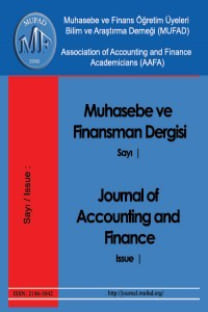Finansal Riskten Korunma Muhasebesinde Etkinliğin Ölçülmesi
Bu makalenin amacı, etkinlik testi yöntemlerinin incelenmesidir. TMS 39, riskten korunma muhasebesi uygulanabilmesi için riskten korunmanın etkin olması şartını getirmiştir. Etkinlik testi, riskten korunma muhasebesi uygulamasında en önemli unsurdur. Riskten korunmanın etkinliğinin, korunma döneminin başında ve daha sonra her üç ayda bir veya en azından bilanço raporlama dönemlerinde ölçülmesi zorunlu tutulmaktadır. UMS 39 riskten korunmada etkinliğin test edilmesinde geçmişe yönelik ve geleceğe yönelik olarak iki yöntem önermektedir fakat etkinliğin nasıl ölçüleceğini belirtmemektedir. Şirketler, riskten korunmada etkinliğin ölçülmesi işleminde Rasyo Analizi, Regresyon Analizi, Kuramsal Türev Enstrüman veya Varyansın Küçültülmesi yöntemlerinden birini seçebilir. Etkinliğin ölçülmesinde kullanılacak yöntemin mantıklı olmasını ve riskten korunma dönemi boyunca aynı yöntemin değiştirilmeden kullanılmasını önermektedir.
Anahtar Kelimeler:
TMS 39, UMS 39, riskten korunmanın etkinliği, geleceğe yönelik test, geçmişe yönelik test
Effectiveness Test In Hedge Accounting
The aim of this article is to review the effectiveness testing methodologies. TAS 39 requires hedging strategies must be tested to for effectiveness in order to apply hedge accounting. Effectiveness is the most important aspects of achieving hedge accounting. Hedge effectiveness must be evaluated at the inception of hedge and then monitored at each three months or at least each balance-sheet date. IAS 39 requires two separate tests; a prospective test and a retrospective test but doesn’t provide specific guidance about how effectiveness tests are performed. Enterprises can choose Ratio Analysis, Regression Analysis, and Hypothetical Derivative or Varyans Reduction method for assessing hedge effectiveness. The method of assessing effectiveness must be reasonable and consistent throughout the life of the hedging relationship.
Keywords:
TAS 39, IAS 39, hedge effectiveness, prospective test, retrospective test,
- ISSN: 2146-3042
- Yayın Aralığı: Yılda 4 Sayı
- Başlangıç: 2005
- Yayıncı: Muhasebe ve Finansman Öğretim Üyeleri Derneği (MUFAD)
Sayıdaki Diğer Makaleler
Kıdem Tazminatı Karşılığı Uygulamasının Muhasebe Standardı (IAS-TMS 19) Kapsamında Değerlendirilmesi
Türkiye’de Meslek Yüksekokullarındaki Eğitimin Muhasebe Mesleğine Katkısı Üzerine Bir Araştırma
Ümit Gücenme GENÇOĞLU, Gülsün İŞSEVEROĞLU
Fatma Ulucan Özkul, Gülçin Tapşın
Sürekli Muhasebe Meslek Eğitiminin Önemi ve Bir Değerlendirme
Yeni Bir Maliyetleme Sistemi Olarak Değer Akış Maliyetleme
Bir Bilgi Sistemi Olarak Muhasebenin Kobi’lerin Yönetim Kararlarına Etkisi: Erzurum Araştırması
